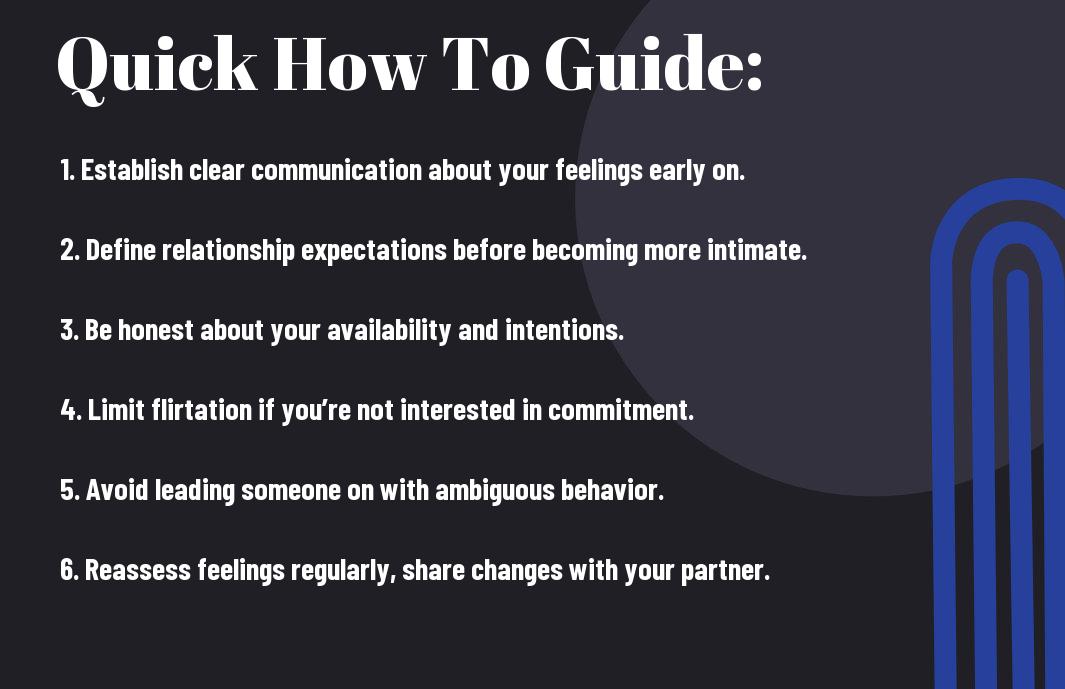Signals often get tangled when you enter the dating scene, leading to confusion for both you and your potential partner. To foster clear communication and build a healthy connection, it’s important to understand how your actions and words can be perceived. In this guide, you’ll learn practical tips for expressing your feelings authentically, aligning your messages, and establishing boundaries that resonate with your intentions. By gaining clarity in your interactions, you can create a more enjoyable and transparent dating experience.
Understanding Mixed Signals
A mixed signal can feel like emotional whiplash, leaving you confused and questioning your partner’s intentions. These signals often manifest as contradictory behaviors or messages that create uncertainty about the status of your relationship. By becoming aware of what mixed signals look like, you can navigate your dating life with more clarity and confidence.
Defining Mixed Signals
With mixed signals, you might encounter a blend of positive and negative cues that suggest different levels of interest or commitment. For instance, your date may express enthusiasm one moment and withdraw the next, leading you to feel uncertain about their true feelings. Understanding this phenomenon is vital for maintaining clear communication in your romantic pursuits.
Common Causes of Mixed Signals
There’s a myriad of reasons why mixed signals can occur in dating. Lack of communication skills, personal insecurities, or even external pressures can contribute to inconsistent behavior. As a result, both you and your potential partner may unintentionally convey mixed messages that create misunderstandings.
This inconsistency often stems from varying emotional states or fear of vulnerability. You might find yourself expressing interest while simultaneously holding back, leading to confusion for the other person. Relationships can be complex, and external factors such as past experiences or societal expectations may influence how openly you or your date fluctuate between wanting closeness and needing space. By recognizing these causes, you can better navigate the dating landscape and be more mindful of how you communicate.

How to Communicate Clearly
You need to express your feelings and intentions plainly to avoid misunderstandings when dating. Clear communication lays the groundwork for a healthier relationship by ensuring both you and your partner are on the same page.
Verbal Communication Tips
For effective verbal communication, consider the following tips:
- Be honest about your feelings.
- Use “I” statements to express your thoughts.
- Ask questions to clarify any doubts.
After you share your feelings, encourage your partner to do the same to foster open dialogue.
Nonverbal Communication Tips
Communication extends beyond words—nonverbal cues play a significant role in conveying your emotions. Consider these tips to enhance your nonverbal communication:
- Maintain eye contact to show engagement.
- Be aware of your body language and gestures.
- Match your facial expressions to your words.
Knowing how to interpret these signals can help you better understand your partner’s emotions and intentions.
Nonverbal communication encompasses a wide range of signals, including posture, gestures, and tone of voice. Pay attention to these cues, as they often convey more than spoken words. For example, crossed arms may indicate defensiveness, while leaning in can show interest. You can create a more intuitive connection with your partner by aligning your verbal and nonverbal signals. This alignment enhances mutual understanding and builds trust in the relationship. Knowing this, you’ll be able to communicate both effectively and authentically.

Factors Influencing Your Signals
All the interactions you have while dating are shaped by various factors that influence the signals you send out. Understanding these can help you communicate more effectively. Key influences include:
- Your mood and emotional state
- Past relationship experiences
- Your personality traits
- Social environment and peer influences
Any of these factors can lead to mixed messages, making it necessary to be mindful of them in your dating life.
Personal Expectations
If you enter a relationship with specific expectations, it may color how you communicate. You might project your desires onto your partner, which can lead to misunderstandings. Be clear with your intentions to foster a healthier connection.
Emotional Availability
Signals you send are often influenced by your emotional availability. If you’re not fully open and present, it may be hard for others to read your intentions accurately.
With emotional availability, you must assess your readiness to engage deeply with another person. If you find yourself still processing past relationships or not fully invested, it’s unlikely you will convey the right signals. Being honest with yourself about your feelings and readiness helps in creating more transparent communication, paving the way for healthier interactions.
Building Trust and Honesty
Many people overlook the significance of trust and honesty when dating, yet these elements are foundational for a healthy relationship. When you are open and sincere in your interactions, you foster an environment where both you and your partner feel safe and valued. By demonstrating your commitment to transparency, you minimize the risk of misunderstandings and prevent sending mixed signals, ultimately paving the way for deeper connections.
Importance of Transparency
Importance of transparency cannot be stressed enough; when you share your thoughts, feelings, and intentions openly, you set a precedent for honest communication. This practice not only helps each of you understand each other better but also reassures both parties that there are no hidden agendas or uncertainties. By being forthright, you enhance the bond you share, making it easier to navigate the complexities of dating.
Establishing Boundaries
Boundaries serve as necessary guidelines that help both partners navigate their relationship comfortably. Being clear about your limits fosters respect and understanding while allowing you to communicate your needs effectively. This proactive approach can prevent emotional confusion and ensure that both you and your partner remain aligned in your dating journey.
For instance, establishing boundaries might involve discussing how often you wish to communicate or what behaviors make you feel uncomfortable. By voicing these preferences, you allow your partner to understand your limits while also encouraging them to share theirs. This open dialogue not only strengthens your relationship but also minimizes the potential for mixed signals, ensuring that both of you feel heard and respected throughout the dating process.
Strategies for Consistency
Keep your dating experience straightforward by establishing consistent behaviors and communication patterns. This means being mindful of your actions and messages to ensure they align, creating a stable environment where both you and your partner feel secure. Consistency builds trust and makes it easier for both of you to understand the direction of your relationship, preventing unnecessary confusion or misunderstandings.
Aligning Actions with Words
To foster genuine connections, ensure your actions match your words. When you express your feelings or intentions, you should demonstrate them through your behavior. If you say you enjoy spending time together, make the effort to initiate plans or be present. This alignment reassures your partner that you are sincere, enhancing the authenticity of your relationship.
Regular Check-Ins
Now, committing to regular check-ins with your partner can help maintain clarity in your relationship. These discussions allow you to express thoughts, feelings, and concerns openly. By fostering a habit of sharing your perspectives, you can address any misconceptions before they escalate into larger issues. This practice also reassures both of you that you are still on the same page and making progress together.
This practice creates a safe space for open dialogue, ensuring both you and your partner feel comfortable sharing insights about your relationship. It can be casual or more structured—what matters is that you dedicate time to discuss how you both feel about the direction of your connection. Regular check-ins not only enhance understanding but also reinforce your commitment to each other, paving the way for a more fulfilling and harmonious dating experience.
Tips for Navigating Difficult Conversations
For effective communication while dating, it’s important to approach sensitive topics with care. Here are some tips to help you navigate these conversations:
- Choose the right time and setting.
- Be clear and honest about your feelings.
- Practice active listening.
- Be open to their perspective.
Recognizing the importance of these conversations can lead to a deeper understanding and connection.
Approaching Sensitive Topics
You should always aim to create a supportive environment when discussing sensitive issues. This means being respectful and empathetic while expressing your own thoughts and emotions. Clear communication can help clarify intentions and minimize misinterpretations.
Handling Disagreements Maturely
Even in the healthiest relationships, disagreements are inevitable. It’s how you handle these situations that can make all the difference. Approaching conflicts with an open mind allows for constructive dialogue, fostering respect and understanding.
For instance, if you disagree about something important, focus on expressing your feelings rather than blaming your partner. Use “I” statements to communicate how you feel, such as “I feel hurt when…” This shifts the conversation towards your emotions and opens up a space for dialogue instead of defensiveness. By remaining calm and respectful, you’re more likely to achieve a resolution that honors both perspectives.
Final Words
On the whole, avoiding mixed signals while dating requires clear communication and honesty about your feelings and intentions. Be mindful of your words and actions, ensuring they align with each other. Establish boundaries early on and don’t hesitate to ask questions for clarity. Regularly check in with your partner to gauge their feelings and reinforce understanding. By fostering an open dialogue, you create a healthy dating environment where both you and your partner feel secure and on the same page.










